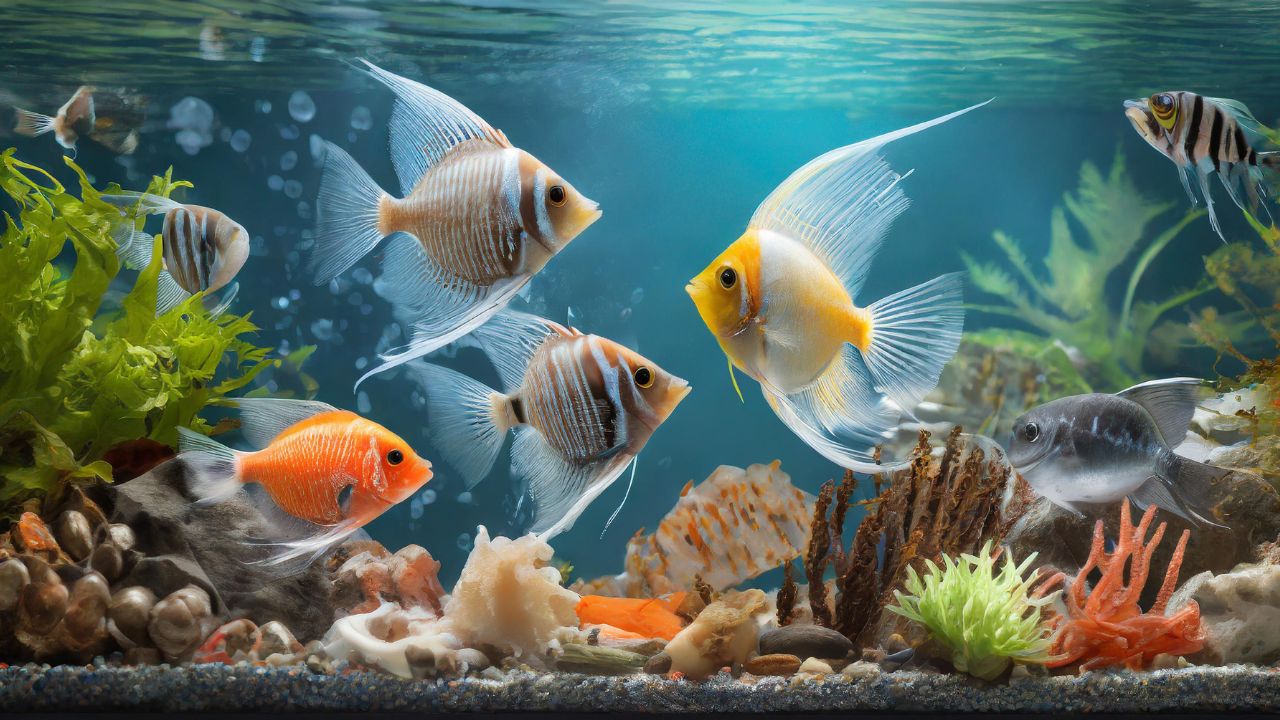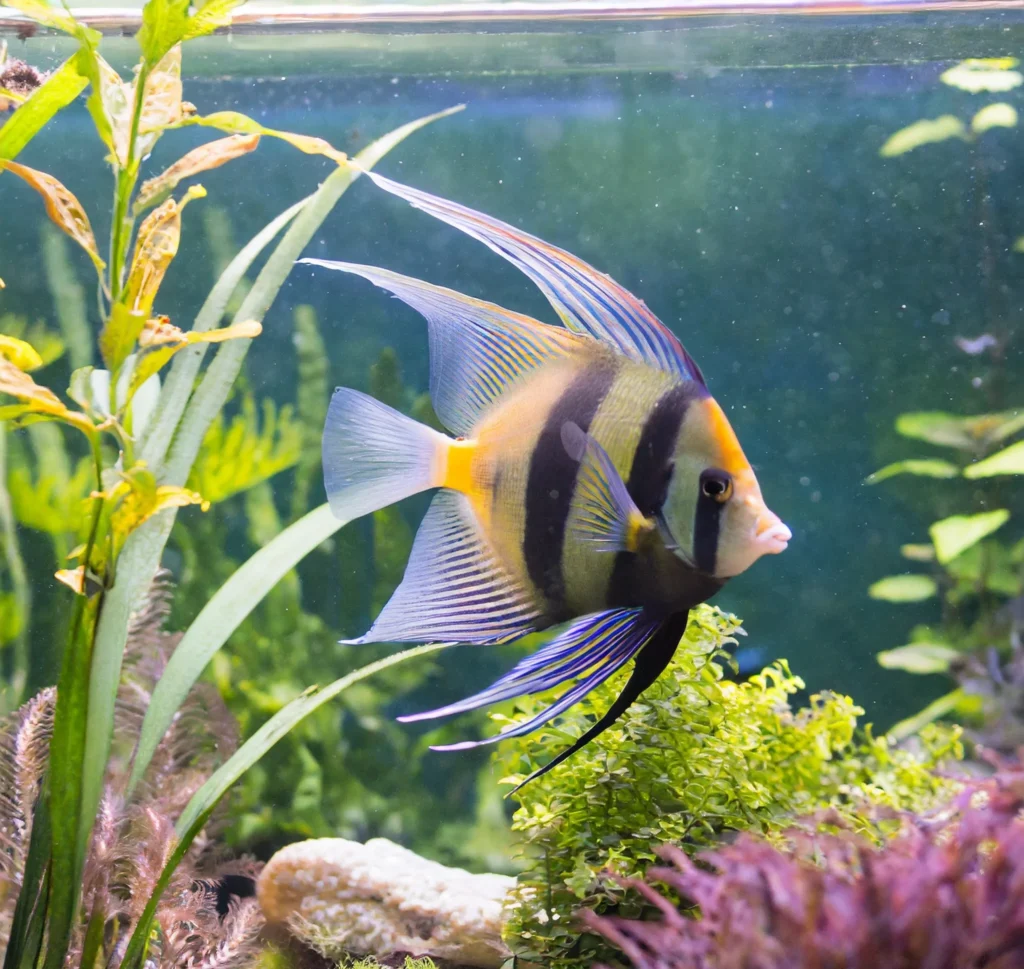
While keeping Angelfish, An important part of angelfish care is to aware about the common angelfish diseases, Its Causes , Symptoms and Cure.
These fishes are some of the most popular freshwater aquarium fish, But like any other fish they can also suffer from a variety of freshwater diseases. Angelfish owners must educate themselves on the most common angelfish diseases in order to properly treat their sick fish.
In this ultimate guide, We will cover 13 of the most common angelfish disease with pictures, their causes, symptoms to look out for possible treatments.
Common early warning signs of sickness in angelfish include lethargy, loss of appetite, clamped fins, labored breathing, white spots, reddening or inflammation, bloating, and more. With attentive care and quick response, most angelfish diseases can be successfully treated if caught early.
Common Angelfish Diseases.
Name of the 13 most prevalent freshwater angelfish diseases include:
- – Dropsy
- – Ich (Ick)
- – Fin Rot
- – Velvet Disease
- – Angelfish Hexamita
- – Gill Flukes
- – Anchor Worms
- – Swollen Belly
- – Mouth Fungus
- – Popeye
- – Cotton Wool Disease
- – Swim Bladder Disorder
- – Virus Infections
Below we will go over each illness in detail, with photos, causation, symptoms, and treatment options.
Angelfish Dropsy.
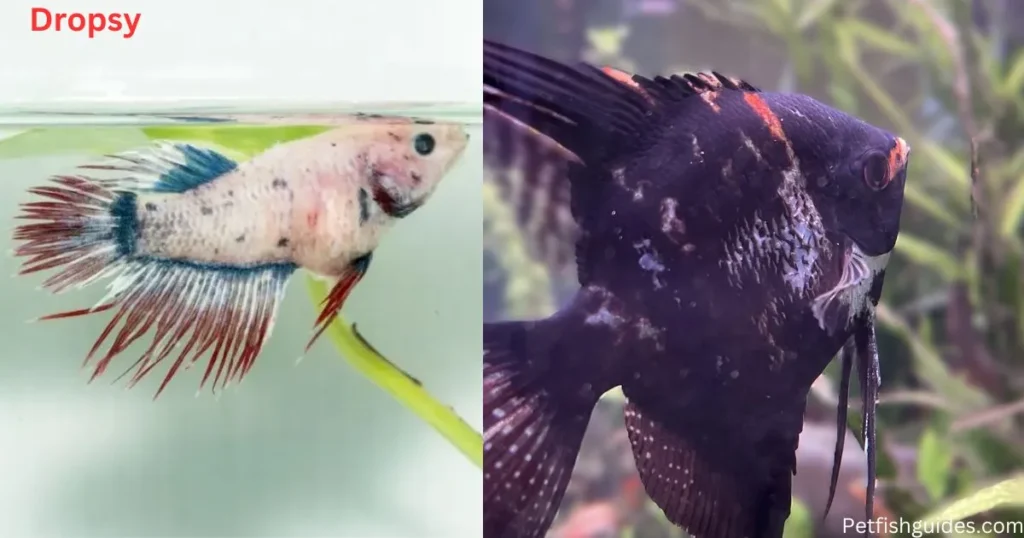
Angelfish Dropsy Cause:
Dropsy is a Angelfish disease about which angelfish owners needs to be aware of.
Dropsy is caused when the immunity of your fish is compromised , Because of compromised immune system bacteria enters the system and causes Dropsy. Poor water quality and stress would be the reason. The bacteria affect the kidney which leads to excess fluid occurrence in body.
Angelfish Dropsy Symptoms:
– Raised scales in breathing
– Swollen, bloated belly
– Bulging eyes
– Lethargy and loss of appetite
Angelfish Dropsy Treatment:
If unable to do early diagnosis, Sadly this can easily kill the fish.
-Take your fish to vet as soon as possible.
-separate the fish to avoid infection to other fishes.
-Add Epsom salt in the water to flush out bacteria.(⅛ teaspoon in 5 gallon)
– Add antibacterial medications with food.
– Increase temperature slightly
– Improve tank conditions and reduce stressors
– Feed antibacterial foods like garlic
Angelfish Ich / Ick (White Spot Disease).
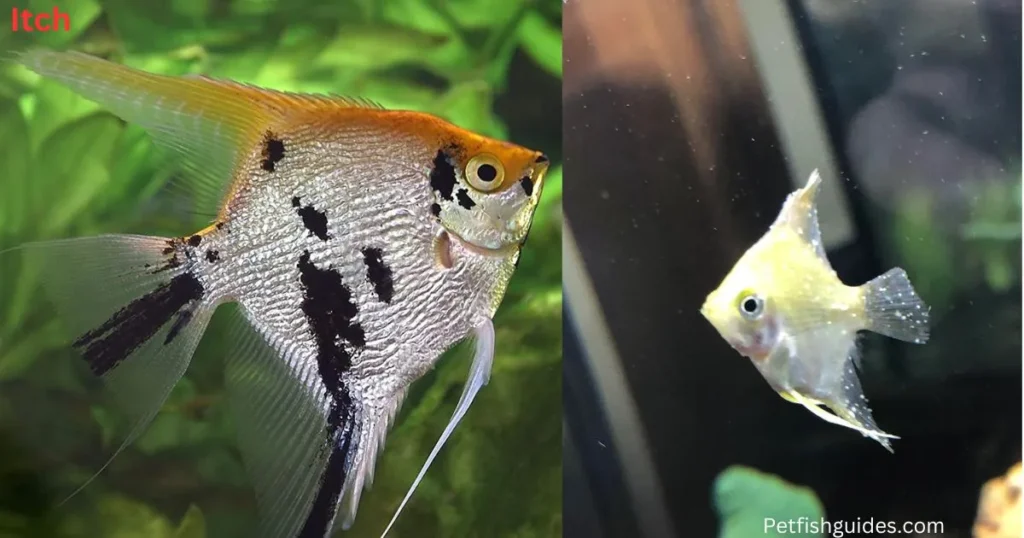
Angelfish Ich Cause:
Ich / White spot is caused by the ciliate parasite Ichthyophthirius multifiliis. All fish carry this parasite but outbreaks often result from sudden change in water temperature, stress or introduction on new fish or plants which carry protozoa from an infected tank. It is highly Contagious and leads to tissue damage and death.
Angelfish Ich Symptoms:
– White grain-like spots all over body and fins
– Increased mucus production
– Flashing/rubbing against objects
– Labored breathing
– Lethargy, loss of appetite
Angelfish Ich Treatment:
-Anti-parasitic medication after consulting with vet immediately.
-Quarantine affected fish to separate tank.
– Raise tank temperature slowly to 86°F
– Treat with medications like formaldehyde or malachite green
– Remove activated carbon from filter during treatment for effectiveness.
– Increase aquarium salt concentration
Angelfish Fin Rot.
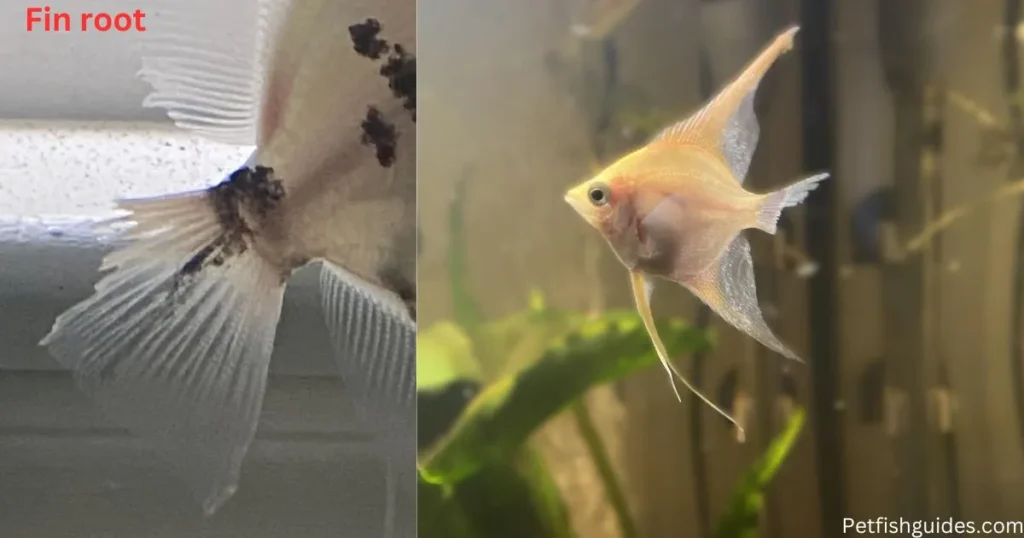
Angelfish Fin Rot Cause:
Fin rot is caused by bacteria opportunistically infecting the fins due to poor water quality, stress, or injury. Angelfish fin root commonly appears in freshwater aquariums with bad water quality. Common culprits are Flavobacterium Columnare, Pseudomonas, or Aeromonas. Unfortunately the damaged tissue is irreversible.
Angelfish Fin Rot Symptoms:
– Frayed fins with reddish edge
– Black or white edges on fins
– Pieces missing from fins
– Lethargy
-Difficulty in swimming at the advance stage of disease.
Angelfish Fin Rot Treatment:
– Improve water quality and reduce stress
-Monitor the water parameter regularly and change at least 50% water daily.
– Add aquarium salt at therapeutic dose
– Antibiotics like Tetracycline, Kanamycin, or Nitrofurazone with vet consultation.
– Antifungal medications if fungal infection.
Angelfish Velvet Disease (Gold Dust Disease).
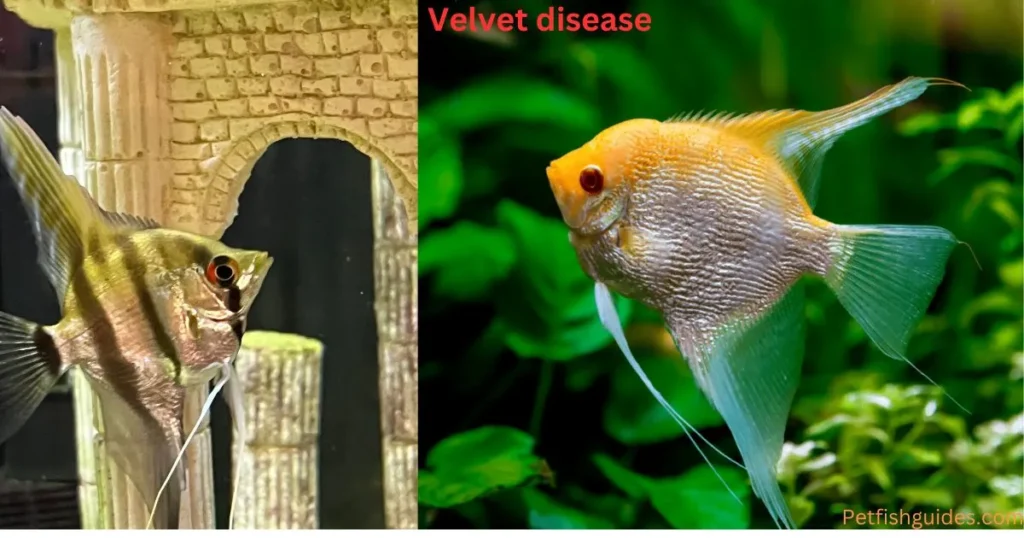
Angelfish Velvet Disease Cause:
Velvet disease Gold Dust Disease is caused by Piscinoodinum or velvet parasites attaching to contaminated fish or equipments. It attacks the body of the fish forming a cyst in the natural slime coating of the angelfish and then erupting through the skin. Outbreaks occur when parasites rapidly multiply faster than fish immune response.
Angelfish Velvet Disease Symptoms:
– Loss of color/faded appearance
– Yellowish “dusting” on skin and fins
– Increased mucus
– Rubbing/flashing against objects
– Labored breathing
– Lethargy and inappetence
Angelfish Velvet Disease Treatment:
– Dim lights to reduce stress
– Raise temperature 82-86°F to speed parasite lifecycle
– Treat with combinations of formalin, malachite green, methylene blue, and copper
– Repeat treatments to kill newly hatched parasites
Angelfish Hexamita (Hole in the Head Disease).
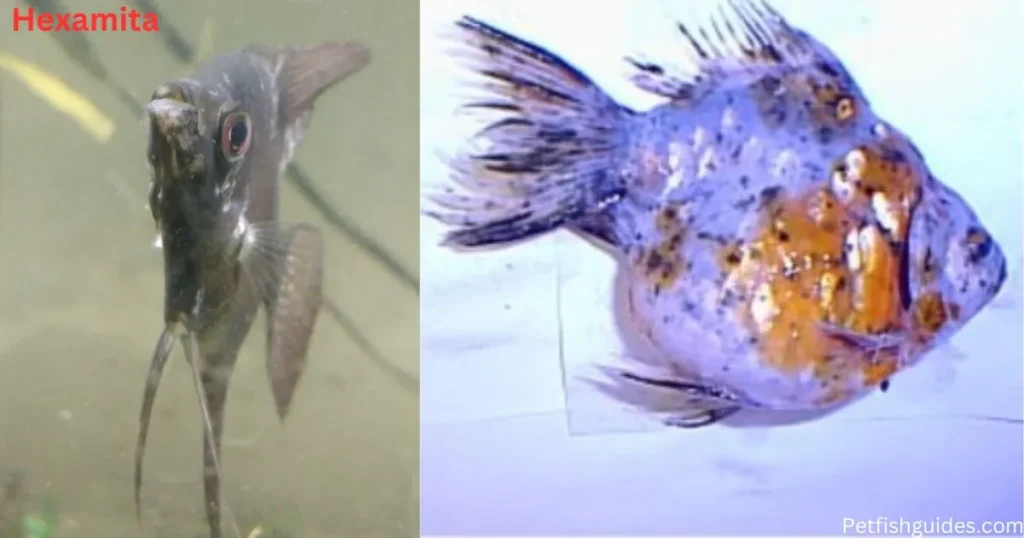
Angelfish Hexamita Cause:
Hexamita known as Hole in The Head disease is caused by the Spironucleus vortens parasite infecting the lateral lines. Exact causation is still debated but poor nutrition and water quality allow the infection to take hold.
Angelfish Hexamita Symptoms:
– Indented holes on the head
– White mucusy patches near lesions
– Abnormal head/lateral line erosion
– Loss of appetite
– Stunted growth
– Scratching against objects
Angelfish Hexamita Treatment:
– Improve diet with varied live and frozen foods
-Quarantine the affected fish.
– Maintain excellent water quality
– Treat with metronidazole, nitrofurazone, tetracycline, or other antibacterials
– Prolonged treatment often needed to fully eliminate parasites
Angelfish Gill Flukes.
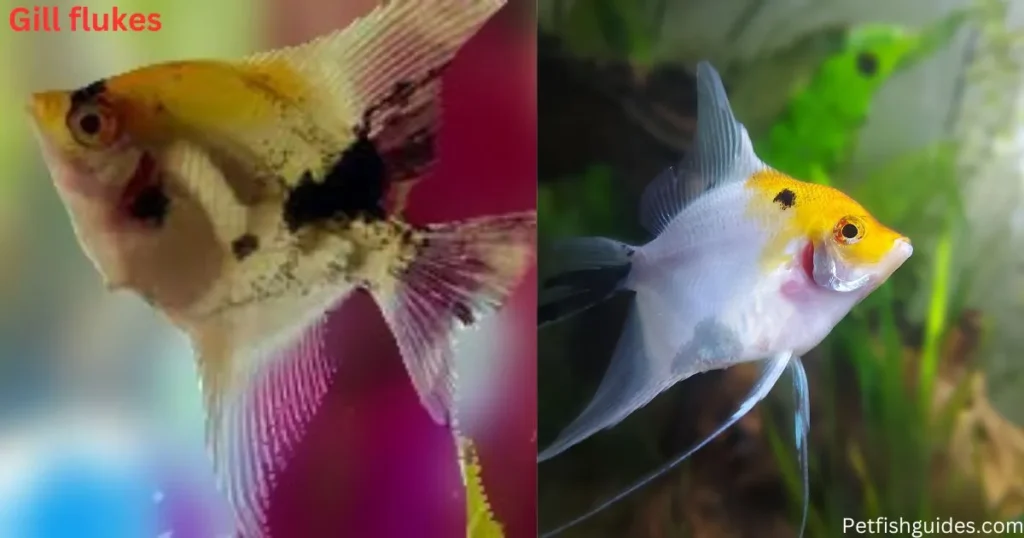
Angelfish Gill Flukes Cause:
Gill flukes are caused by trematode parasites like Dactylogyrus and Gyrodactylus that infect the gills. Heavy infestations often result from introduction on new fish.
Angelfish Gill Flukes Symptoms:
– Clamped fins
– Labored, heavy breathing
– Gasping at surface
– Reduced gill movement
– Scratching on objects
– White mucus hanging from gills
Angelfish Gill Flukes Treatment:
– Quarantine and treat new fish
– Use praziquantel, mebendazole, or organophosphates
– Multiple treatments often needed
– Remove carbon from filter during treatment
Angelfish Anchor Worms.
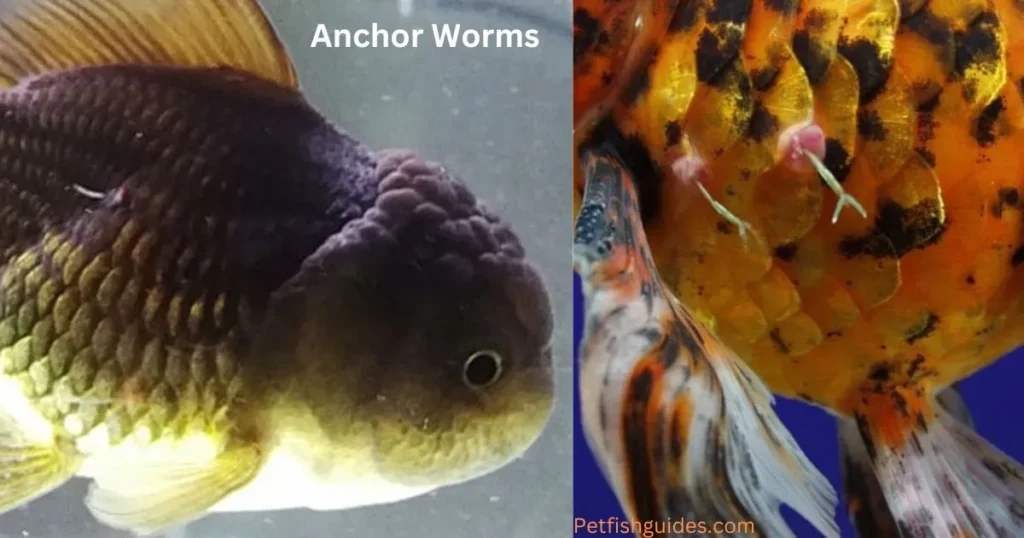
Angelfish Anchor Worms Cause:
Anchor worms are crustacean parasites that bury into the fish’s flesh. Outbreaks can spread quickly between fish.
Angelfish Anchor Worms Symptoms:
– Small red worms up to 20mm long attached to body
– Irritation, scratching against objects
– Open sores at attachment sites
– Loss of appetite
Angelfish Anchor Worms Treatment:
– Dim lights to reduce stress
– Gently remove visible worms with tweezers
– Treat water with organophosphates like trichlorfon
– Repeat treatments to kill immature worms
Angelfish Swollen Bellies (Big Stomach).
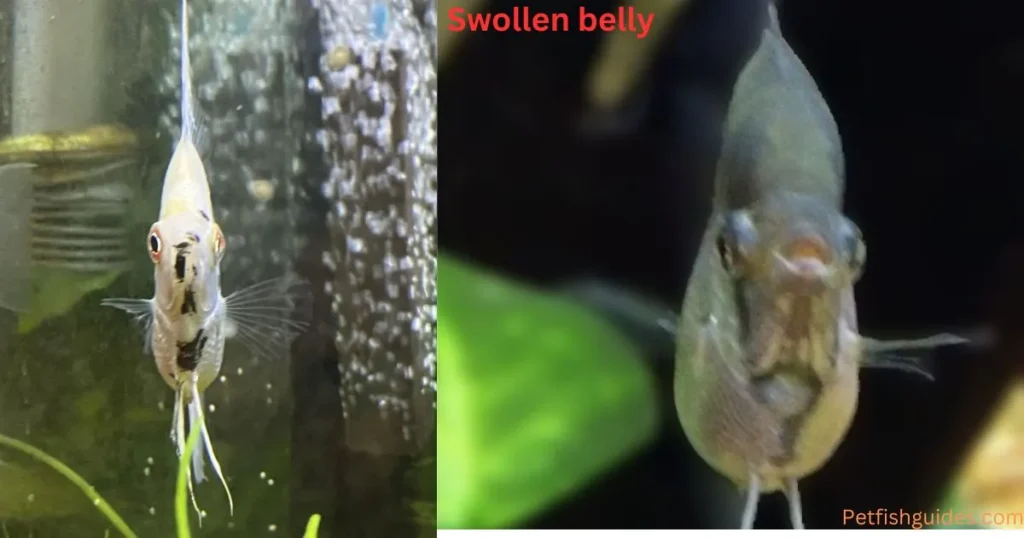
Angelfish Swollen Bellies Cause:
Swollen bellies have several potential root causes including dropsy, hexamita, intestinal parasites, constipation, egg impaction, or organ failure.
Sometime swollen belly appears while the fish is preparing for spawn or to lay eggs. This is not to be consider as illness, But close monitoring is necessary.
Angelfish Swollen Bellies Symptoms:
– Enlarged, swollen stomach/abdomen
– Loss of appetite
– Weight loss
– Lethargy
– Possibly raised scales
Angelfish Swollen Bellies Treatment:
– Treat potential underlying infections based on other symptoms
– Feed peas to relieve constipation
– In severe cases, gently massage and dis impact eggs
Angelfish Mouth Fungus.
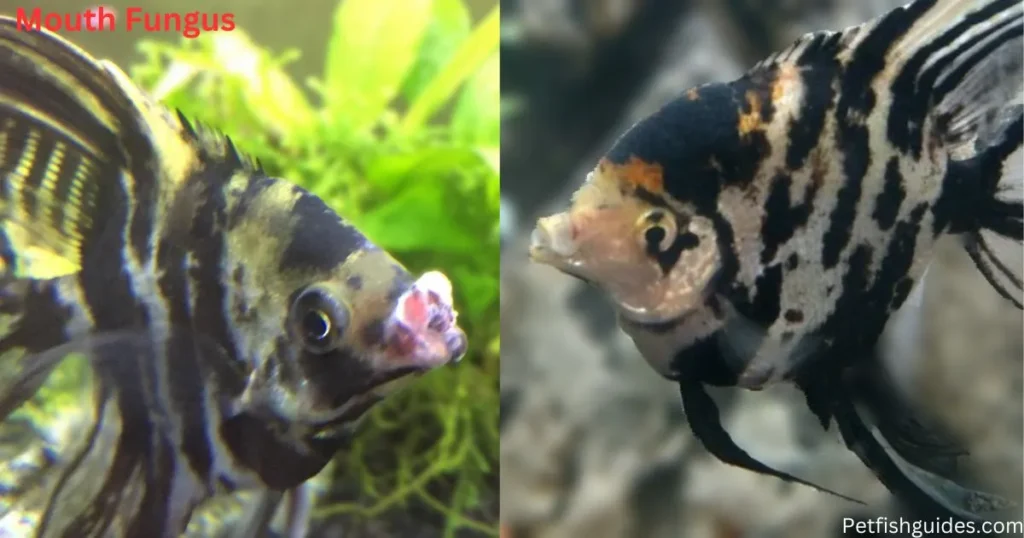
Angelfish Mouth Fungus Cause:
Mouth fungus is caused by saprolegnia fungal spores opportunistically attacking tissue damaged by injury, poor nutrition or stress. Secondary bacterial infections also occur.
Angelfish Mouth Fungus Symptoms:
– White cottony growth around mouth
– Eroded mouth/jaw tissue
– Red exposed areas
– Difficulty eating
– Clamped fins
Angelfish Mouth Fungus Treatment:
– Antibacterial and antifungal medications
– Treat injuries/wounds
– Ensure adequate nutrition
– Add aquarium salt
– Increase tank temperature
Angelfish Popeye.
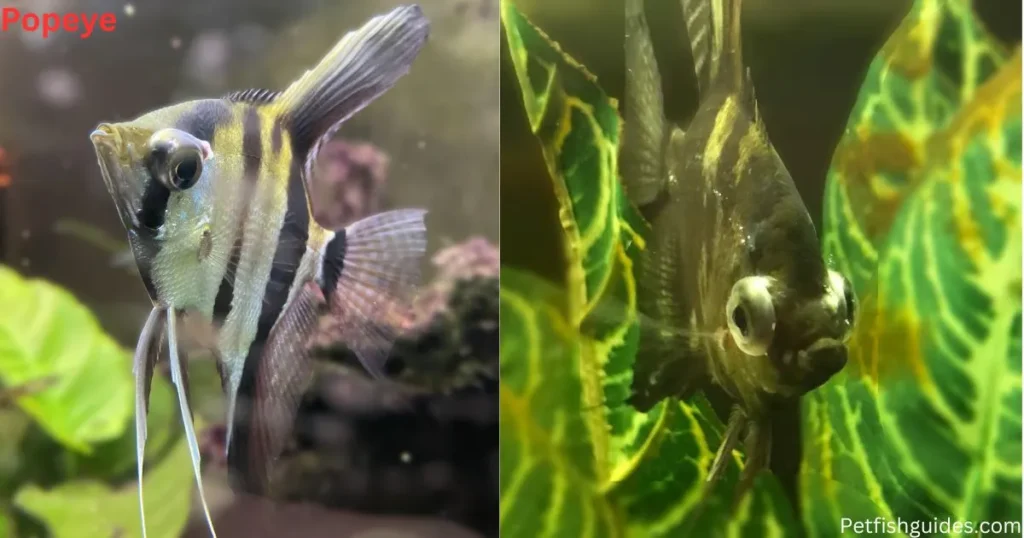
Angelfish Popeye Disease Cause:
Popeye is caused by bacterial infections behind the eye, leading to fluid accumulation and swelling. Causative bacteria include Streptococcus and Pseudomonas species.
Angelfish Popeye Disease Symptoms:
– One or both eyes protruding out
– Possible reddening around swollen eye
– Difficulty seeing, swimming, feeding
– Lethargy
– Possibly raised scales or fins
Angelfish Popeye Disease Treatment:
– Identify and treat underlying infection with broad spectrum antibiotic
– Kanamycin or tetracycline often effective
– If severe, eye may need to be surgically excised
– Ensure excellent water quality
Angelfish Cotton Wool Disease.
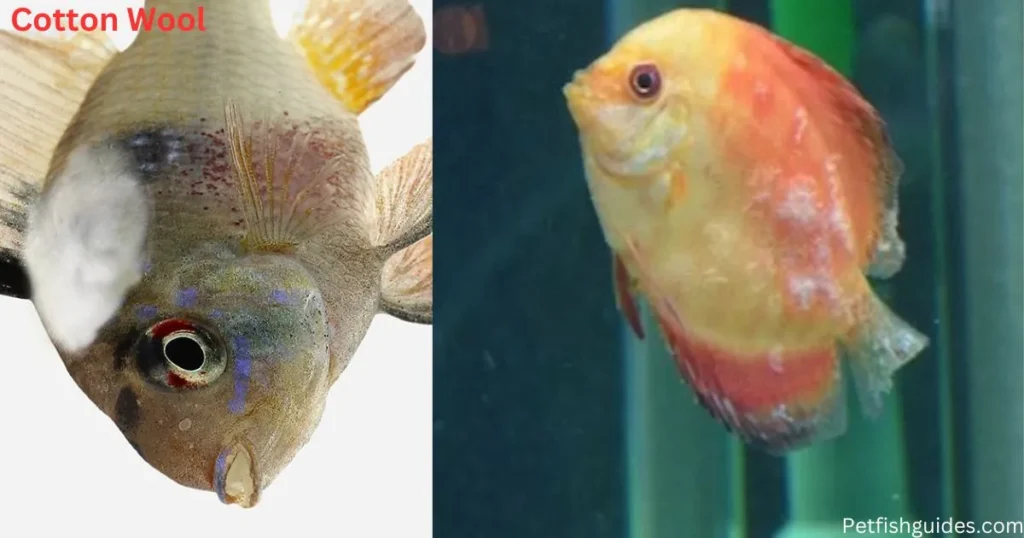
Angelfish Cotton Wool Disease Cause:
Cotton wool disease is caused by fungal infections of fins and body. Secondary bacterial infections also frequently occur. Outbreaks happen with injury and stress.
Angelfish Cotton Wool Disease Symptoms:
– White cottony growth on body and fins
– Frayed, damaged fins
– Red ulcerated areas on body
– Lethargy and loss of appetite
– Darkening of skin
Angelfish Cotton Wool Disease Treatment:
– Combine antifungal and antibacterial medications
– Remove necrotic tissue
– Increase aquarium temperature and add salt
– Ensure good nutrition and reduce stress
Swim Bladder Disease.
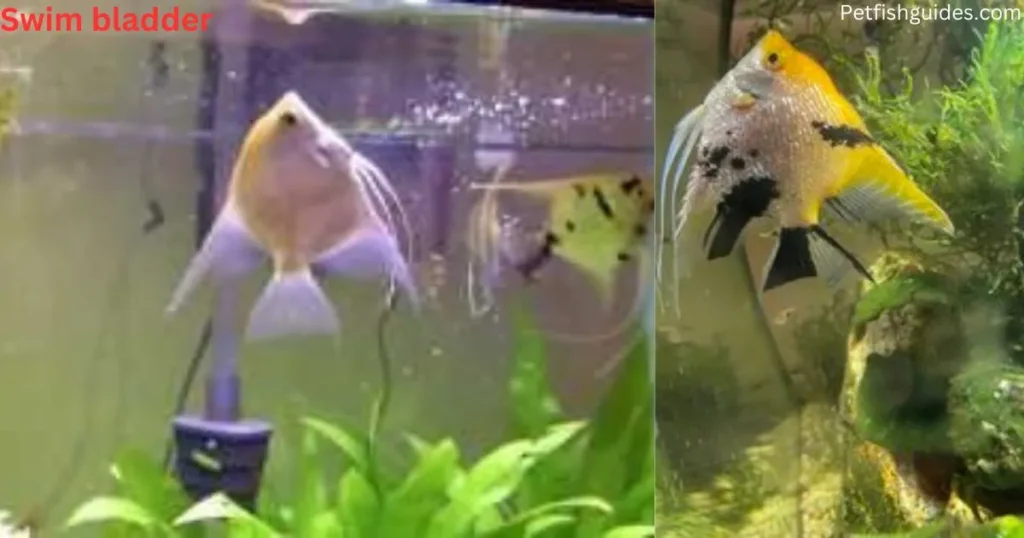
Swim Bladder Disease Cause:
Swim bladder disorders are caused by a disruption in the functioning of the swim bladder organ used for buoyancy. Issues include inflation problems, blockages, infections, cysts and parasites.
Swim Bladder Disease Symptoms:
– Problems staying upright / sinking or floating
– Loss of balance and coordination
– Difficulty swimming and staying level
– Inability to dive or rise normally
Swim Bladder Disease Treatment:
– Feed frozen peas to relieve constipation issues
– Use antibiotic treatments if infection present
– In severe cases, surgery may be needed
– Manage fish buoyancy issues by adjusting tank levels
Angelfish Virus Infections.
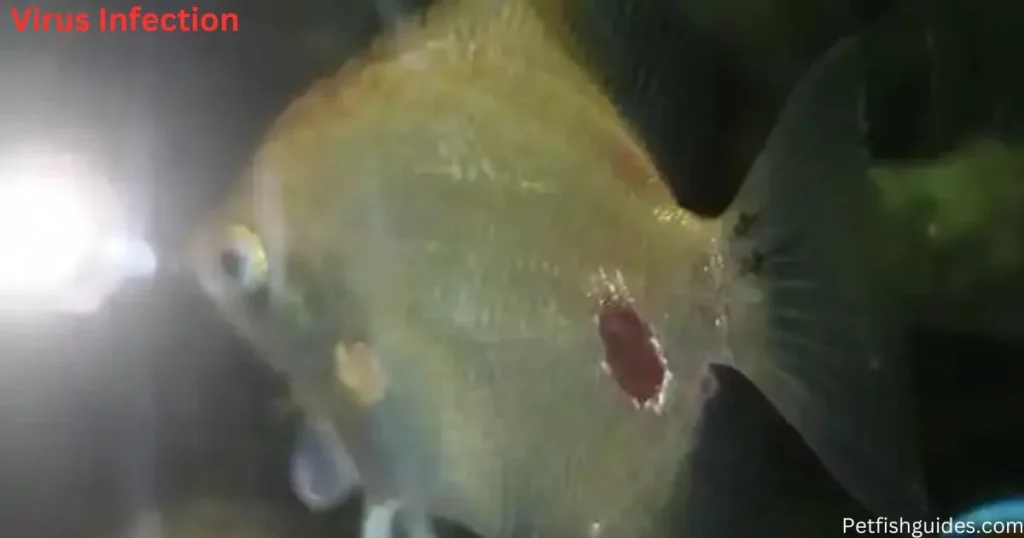
Angelfish Virus Infection Cause:
Virus infection is a very common Angelfish disease. Viruses include those from the iridovirus and herpesvirus groups. Infections tend to be opportunistic, attacking already weakened fish.
Angelfish Virus Infection Symptoms:
– Ulcers/red sores on body
– Fungus on wounds
– Pop-eye
– Bloated abdomen/dropsy
– Neurological problems
– High mortality rate
Angelfish Virus Infection Treatment:
– Quarantine infected fish immediately
– Improve conditions to strengthen immune response
– Treat secondary fungal and bacterial infections
– No direct antiviral treatments for fish currently exist
– Control mortality spread with euthanasia
How to Monitor Angelfish Health.
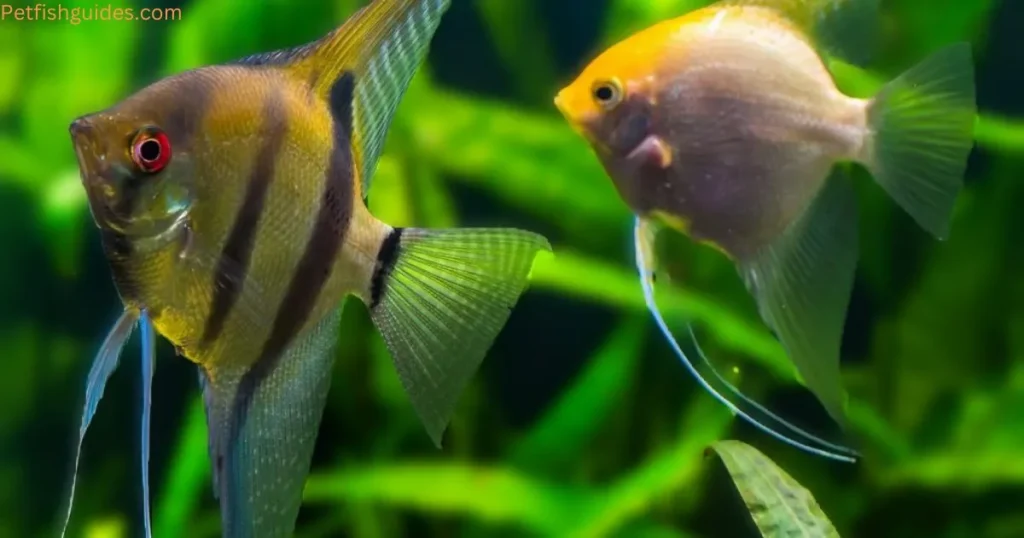
Prevention is the best medicine for angelfish illness. Some tips:
– Maintain excellent water quality
– Feed a varied, nutritious diet with greens
– Keep tank free from sharp decor injuring fish
– Observe fish daily for any abnormalities
– Quarantine and treat new fish before adding
– Respond quickly at first signs of disease
Final Words.
Angelfish are susceptible to bacterial, parasitic, fungal and viral diseases, especially in non ideal tank conditions. By learning the common angelfish illnesses, causation factors, symptoms, and treatment options you can act quickly and effectively when disease appears. Prevention through proper environment, nutrition and monitoring is also key. Address issues promptly and most angel health problems can be successfully managed.
Disclaimer: This Angelfish disease care guide is purely based on self experience and research. Consultation with Professional veterinary is necessary before proceeding for any treatment.

